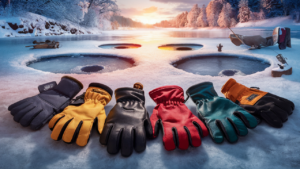To ensure your tent is waterproof, purchase a waterproofing agent and seam sealant. On a clear, dry, and warm day, pitch the tent in an outdoor setting with ample ventilation.
Recommended Best Waterproof Tent Spray 2024-2025
| Recommendation | Product |
| Best Overall | KIWI Camp Dry Heavy-Duty Water Repellent |
| Popular Choice | Scotchgard Outdoor Water Shield |
| Best Value | Nikwax Tent & Gear Care |
| Best Budget | GEAR AID Seam Grip TF Tent Waterproofing |
| Another Excellent Pick | STAR BRITE Waterproofing Spray |
Apply the waterproofing agent to the outside of the tent using a spray or paint. Use a clean cloth to wipe away any drips or excess waterproofing. Allow the tent to dry completely. Remember that not all tents are inherently waterproof, so taking these steps will help protect your tent from rain and moisture.
Additionally, placing a tent footprint or tarp inside the tent and pitching it on a flat or rounded spot can further prevent water infiltration.
The Importance Of Waterproofing Your Tent
Ensuring that your tent is waterproof is crucial to a successful camping trip. To make sure your tent is waterproof, purchase a waterproofing agent and seam sealant, pitch your tent in a well-ventilated area, and apply the waterproofing agent to the outside of the tent.
Be sure to wipe away any excess and allow the tent to dry completely before packing it away.
| Ensures dry camping experience |
| Regular maintenance for longevity |
| Prevents mold and mildew growth |
Waterproofing your tent is crucial. Neglect can lead to wet camping trips, mold, and reduced lifespan. Common myths about waterproofing can misguide campers.

Identifying Waterproofing Weaknesses
When checking the waterproofing of your tent, it’s essential to inspect the seams and fabric for any signs of weakness. Look for peeling tape or visible needle holes along the seams, as these could be potential leakage points. Additionally, examine the fabric for any areas where water may be seeping through, such as worn-out or damaged sections.
If you notice any weaknesses in the waterproofing, it’s time to reapply the waterproofing treatment. This can be done using specialized waterproofing agents and seam sealants. Make sure to apply the treatment on a clear, dry day with ample ventilation. After application, wipe away any excess and allow the tent to dry thoroughly. By addressing these weaknesses and reapplying the waterproofing, you can ensure that your tent remains effectively protected against water infiltration during your outdoor adventures.
Choosing The Right Waterproofing Products
When choosing waterproofing products for your tent, consider using seam sealants and durable water repellent (DWR) coatings. Seam sealants are essential for sealing the needle holes created during the tent’s manufacturing process, preventing water from seeping through. DWR coatings work by causing water to bead up and roll off the fabric, enhancing its waterproofing capabilities. Look for products specifically designed for outdoor gear to ensure maximum effectiveness. Apply these products carefully and thoroughly to ensure complete coverage, paying special attention to seams and high-wear areas. Regular maintenance and reapplication of waterproofing products will help ensure that your tent remains waterproof and ready for your outdoor adventures.
Preparation Steps Before Waterproofing
To ensure your tent is waterproof, follow these essential preparation steps. First, clean the tent thoroughly to remove dirt and debris. Next, apply a waterproofing agent to the outside, focusing on seams and fabric. Allow the tent to dry completely before your next outdoor adventure.
| Cleaning Your Tent: | Before waterproofing, clean your tent thoroughly to remove any dirt or residue. |
| Selecting the Proper Environment for Application: | Choose a well-ventilated outdoor area for applying the waterproofing agent. |
Seam Sealing Techniques
To ensure your tent is waterproof, mastering seam sealing techniques is essential. Seam sealing involves applying a waterproof sealant to the stitched seams of the tent to prevent water from seeping through. This process helps maintain a dry and comfortable camping experience, especially during rainy conditions.
Applying Waterproof Coatings
To ensure your tent is waterproof, apply a waterproof coating to the outside of the tent fabric and seam sealers to the seams. It’s important to clean the coating and refresh the DWR coating before wiping off any excess. Pitch the tent in an outdoor setting for ventilation and allow it to dry thoroughly.
| Applying Waterproof Coatings | |
| – Use spray-on waterproofers for easy application. | – Consider paint-on methods for more thorough coverage. |
In order to ensure your tent is waterproof, it is important to apply waterproof coatings properly. Using spray-on waterproofers can provide a quick and effective way to protect your tent from moisture. On the other hand, paint-on methods offer a more comprehensive coverage, ensuring all areas are adequately sealed. By following these techniques, you can enhance the waterproofing of your tent and enjoy a dry camping experience.
Post-waterproofing Care
After waterproofing your tent, it’s crucial to let it dry and cure completely before storing it. Ensure the tent is completely dry before packing it away to prevent mold and mildew. Additionally, store the tent in a cool, dry place away from direct sunlight to maintain the waterproofing. Avoid storing the tent in a compressed state for extended periods as this can compromise the waterproof coating. Regularly inspect the tent for any signs of damage or wear and tear, and address any issues promptly to preserve the waterproofing.
Real-world Waterproofing Tests
Conducting a Water Hose Test: To check for leaks, spray the entire tent with a water hose, paying special attention to the seams and zippers. Assessing Waterproofing Effectiveness: Observe the interior for any signs of water seepage, and note any areas that may require additional waterproofing treatment.
Additional Protective Measures
For additional protection, consider using a tent footprint to prevent ground moisture from seeping in. When pitching in wet conditions, make sure to seal seams properly and refresh the waterproof coating. It’s essential to clean and maintain the tent fabric to ensure longevity. Consider using waterproofing agents and seam sealants for optimal waterproofing. Allow for proper ventilation during the application process and wipe away any excess product. Remember, tent waterproofing is a preventive measure and should be done as needed, not necessarily annually.
Frequently Asked Questions
How Do I Make My Tent Waterproof?
To make your tent waterproof, use a waterproofing agent and seam sealant on a clear, dry day. Apply outside, wipe away excess, and let it dry.
Should I Spray My Tent With Waterproof Spray?
Yes, it is recommended to spray your tent with waterproof spray. It acts as a preventative measure to protect your tent from water penetration. It is easy and affordable to apply, but it may not be necessary to do it every year unless your tent starts showing signs of water leakage.
How To Protect Your Tent From Rain?
To protect your tent from rain, use a waterproofing agent and seam sealant. Pitch the tent in a well-ventilated area and apply the waterproofing agent to the outside of the tent. Ensure any excess is wiped away and allow to dry.
Place a tent footprint or tarp inside the tent, pitch the tent on a flat or rounded spot, and use tarps or canopies for extra shelter. Most tents are water-resistant, not waterproof.
Are Any Tents Actually Waterproof?
Not all tents are waterproof. Most tents are water resistant, meaning they slow down rainwater penetration but don’t prevent it completely. To make your tent waterproof, use a waterproofing agent and seam sealant, and ensure proper ventilation when applying.
Conclusion
Ensuring that your tent is waterproof is an essential step to having a successful camping trip. By following the tips outlined in this post, you can make sure that your tent stays dry and comfortable no matter what the weather is like.
Remember to regularly check and maintain your tent’s waterproofing to ensure it continues to work effectively. With these steps, you can enjoy your outdoor adventure without worrying about getting wet or uncomfortable. Happy camping!








